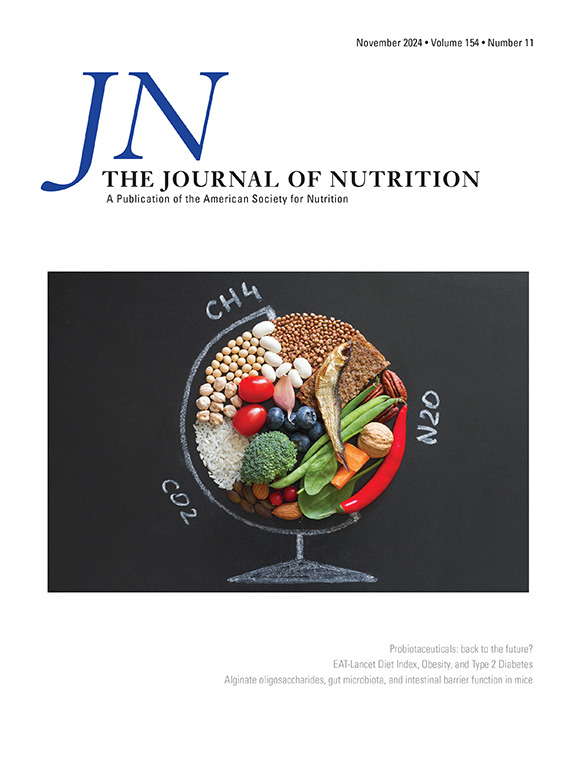Alcohol Reprograms Placental Glucose and Lipid Metabolism, Which Correlate with Reduced Fetal Brain but not Body Weight in a Mouse Model of Prenatal Alcohol Exposure
IF 3.7
3区 医学
Q2 NUTRITION & DIETETICS
引用次数: 0
Abstract
Background
Prenatal alcohol exposure (PAE) impairs fetal growth and brain development. Dysregulated placental function contributes to these deficits. Whether PAE also disrupts its metabolic functions to impede fetal development is unclear.
Objectives
We performed untargeted metabolomics to gain mechanistic insights on how PAE impacts placental metabolism and fetal nutrient availability.
Methods
Pregnant C57BL/6J mice were gavaged with alcohol (ALC, 3 g/kg) or isocaloric maltodextrin (CON) daily on embryonic days (E) E8.5 through E17.5. We performed untargeted metabolomics on placentas harvested at E17.5.
Results
Alcohol reduced placental glucose and glycolytic intermediates and increased tricarboxylic acid (TCA) cycle intermediates, suggesting a shift from glucose to lipids to meet its high energetic demands. This was complemented by elevations in intermediates of the pentose phosphate and glucosamine pathways, indicating a diversion of glucose into nonoxidative fates. Alcohol also decreased aspartate and asparagine, consistent with the limited glucose availability and increased fetal demand for nitrogen acceptors to support its increased gluconeogenesis and urea production. Alcohol also caused a selective increase in purine metabolites despite the limited availability of donor sources glucose, serine, glycine, glutamine, and asparagine. Uridine nucleotides were also elevated and may represent an adaptive change to meet the increased need for thiamin pyrophosphate in the oxidative decarboxylations of the TCA cycle and pentose phosphate pathways. Decreases in multiple oxylipins having antivasoconstriction actions could be a mechanism by which alcohol alters the placental vasculature and promotes vasoconstriction. Importantly, the selective and strong correlation of these dysregulated metabolites with reduced fetal brain weight, but not body weight, affirms the importance of the placenta-brain axis and placental metabolism on brain development.
Conclusions
Alcohol causes metabolic dysregulation and reprogramming of the late-term placenta. These changes limit fetal nutrient availability and contribute to the reduced brain development and cognitive impairments that partly typify PAE.
在产前酒精暴露小鼠模型中,酒精重编程胎盘葡萄糖和脂质代谢,这与胎儿大脑减少有关,但与体重无关。
背景:产前酒精暴露(PAE)损害胎儿生长和大脑发育。胎盘功能失调导致了这些缺陷。PAE是否也会破坏其代谢功能从而阻碍胎儿发育尚不清楚。目的:我们进行了非靶向代谢组学,以获得PAE如何影响胎盘代谢和胎儿营养可利用性的机制见解。方法:在胚胎期(E) E8.5 ~ E17.5,每天给妊娠C57BL/6J小鼠灌胃酒精(ALC, 3 g/kg)或等热量麦芽糊精(CON)。我们对17.5岁时收获的胎盘进行了非靶向代谢组学研究。结果:酒精降低了胎盘葡萄糖和糖酵解中间体,增加了TCA循环中间体,表明从葡萄糖到脂质的转变,以满足其高能量需求。这与戊糖磷酸和葡萄糖胺途径的中间产物的升高相补充,表明葡萄糖转移到非氧化状态。酒精也降低了天冬氨酸和天冬酰胺,这与有限的葡萄糖可用性和增加胎儿对氮受体的需求以支持其增加的糖异生和尿素生成相一致。尽管供体来源葡萄糖、丝氨酸、甘氨酸、谷氨酰胺和天冬酰胺的可用性有限,但酒精也导致嘌呤代谢物选择性增加。尿苷核苷酸也升高,这可能是一种适应性变化,以满足在TCA循环和戊糖磷酸途径的氧化脱羧过程中对焦磷酸硫胺的需求增加。具有抗血管收缩作用的多种氧化脂素的减少可能是酒精改变胎盘血管并促进血管收缩的机制。重要的是,这些失调代谢物与胎儿脑重量减少的选择性和强相关性,而不是体重减少,证实了胎盘-脑轴和胎盘代谢对大脑发育的重要性。结论:酒精导致晚期胎盘代谢失调和重编程。这些变化限制了胎儿的营养供应,并导致大脑发育减少和认知障碍,这在一定程度上是PAE的典型特征。
本文章由计算机程序翻译,如有差异,请以英文原文为准。
求助全文
约1分钟内获得全文
求助全文
来源期刊

Journal of Nutrition
医学-营养学
CiteScore
7.60
自引率
4.80%
发文量
260
审稿时长
39 days
期刊介绍:
The Journal of Nutrition (JN/J Nutr) publishes peer-reviewed original research papers covering all aspects of experimental nutrition in humans and other animal species; special articles such as reviews and biographies of prominent nutrition scientists; and issues, opinions, and commentaries on controversial issues in nutrition. Supplements are frequently published to provide extended discussion of topics of special interest.
 求助内容:
求助内容: 应助结果提醒方式:
应助结果提醒方式:


